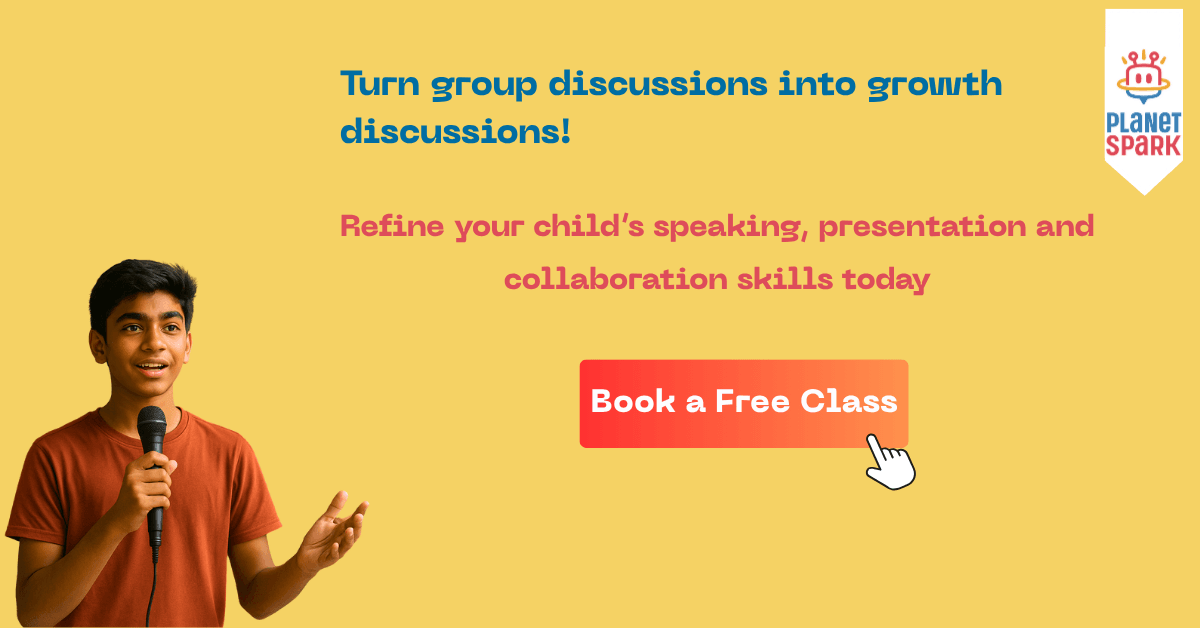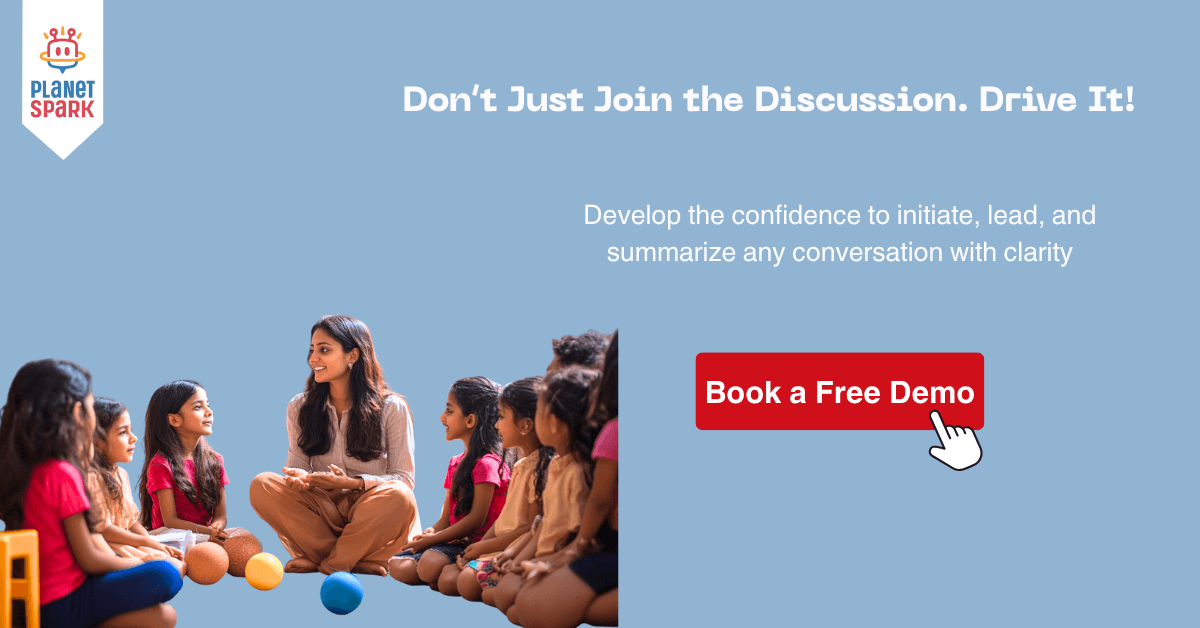Best Group Discussion Starting Lines with Examples | Tips & Guide

Table of Contents
- Types of Starting Lines in Group Discussion
- Examples of Opening Statements for Common GD Topics
- Why Starting a Group Discussion Matters
- What Makes a Great GD Starter?
- 10 Unique Group Discussion Starting Line Templates
- How to Pick the Best Starting Line?
- 6. How to Start a GD When You're Nervous?
- Mistakes to Avoid While Starting a GD
- Importance of Group Discussions
- How to Start a Group Discussion?
- Top Group Discussion Tips
- How PlanetSpark Helps Master GDs and Public Speaking
- Conclusion
- FAQs on Group Discussion Starting Lines
The first few seconds of a group discussion can define your position, build your credibility, and steer the entire conversation. That’s why knowing how to start a group discussion with impact is a powerful skill for students, job seekers, and professionals alike.
In this blog, we’ll break down various types of starting lines for group discussions, explain when and how to use them, and offer real examples to help you practice. We’ll also introduce ways in which PlanetSpark’s Public Speaking Course can help you shine in group discussions and beyond.
Types of Starting Lines in Group Discussion
Let’s explore group discussion starting ines with Examples different ways to start a group discussion effectively, depending on your strategy or topic type.
Definition-Based Starting Lines
This is best when the topic involves abstract ideas or concepts like “Success,” “Leadership,” or “Freedom of Speech.”
Example Starting Line:
“Before we dive into the discussion, let’s first understand what ‘Leadership’ truly means. Leadership isn’t just about authority it’s about influence, vision, and accountability.”
Fact or Data-Based Starting Lines
If the topic is analytical or social in nature like “Climate Change,” “Social Media Impact,” or “Online Education”—starting with statistics or recent facts adds weight to your point.
Example:
“According to a recent UN report, over 1 million species are at risk of extinction due to human activity. This sets the context for why climate change is not just real, but urgent.”
Quote-Based Starting Lines
A quote by a respected figure can act as a strong hook and set an intellectual tone.
Example:
“‘Education is the most powerful weapon which you can use to change the world,’ said Nelson Mandela. This quote perfectly frames today’s discussion on the role of online learning in shaping future generations.”
Examples of Opening Statements for Common GD Topics
Here are real, ready-to-use examples for frequently asked group discussion topics:
Topic: Is Social Media a Boon or Bane?
Opening Line:
“In today’s digital age, social media is both a platform for expression and a potential risk to mental health. This duality makes it essential to evaluate its pros and cons objectively.”
Topic: Should Homework Be Abolished?
Opening Line:
“Homework has long been seen as a tool to reinforce classroom learning, but recent studies suggest it may increase student stress without improving results. Let’s explore if it’s time for a change.”
Topic: Impact of Artificial Intelligence on Jobs
Opening Line:
“Automation and AI are reshaping industries—while they reduce manual jobs, they also create opportunities in data science, robotics, and analytics. So the real question isn’t loss, but adaptability.”
Expand the list and let's find 60+ Public Speaking Topics Ideas with Tips for Beginners
Why Starting a Group Discussion Matters
Initiating a group discussion:
Demonstrates leadership.
Shows confidence and clarity of thought.
Sets the tone and structure of the discussion.
Gives you the advantage of guiding the conversation.
However, many participants hesitate, fearing they might say something wrong or be interrupted. That’s where preparation and structured thinking come in.
Want your child to confidently speak up in group discussions and debates?
Enroll them in PlanetSpark’s Public Speaking Program, we teach children to use storytelling, quotes, and persuasive techniques to open a GD powerfully just like professional speakers!
Book a free demo class!
What Makes a Great GD Starter?
Here are some winning traits of an impactful GD starter:
| Trait | Why It Matters |
|---|---|
| Clear voice | Shows confidence and assertiveness. |
| Relevance | Keeps the group focused. |
| Conciseness | Avoids rambling; gets to the point. |
| Engagement | Invites other members to join in. |
10 Unique Group Discussion Starting Line Templates
Here are templates you can adapt for any GD topic:
“Let me begin by framing the topic from a practical lens…”
“The relevance of this topic lies in…”
“To give this discussion a structured start, let’s first understand the root issue…”
“In the current scenario, this topic holds critical importance because…”
“Here’s a statistic that I believe sets the stage for this conversation…”
“Let’s begin by acknowledging both perspectives of the topic…”
“Before we debate, defining the key term here will help us…”
“A quote I recently came across says…, which perfectly captures this topic’s essence.”
“Allow me to initiate the discussion with a real-life example that resonates with our topic.”
“To open, let’s examine the broader context of this issue from a global perspective.”
How to Pick the Best Starting Line?
Here’s how to decide what approach to use:
| Situation | Best Approach |
|---|---|
| Abstract topic (e.g., freedom, ambition) | Definition or quote |
| Controversial topic (e.g., politics, law) | Balanced view or current affairs |
| Tech/Analytical topic (e.g., AI, environment) | Data/statistics |
| Social topics (e.g., gender roles, education) | Personal story or relevant news |
Boost your child’s stage presence with hands-on training in speech clarity and expression
Start with a free booking today!
6. How to Start a GD When You're Nervous?
Many students hesitate to initiate the discussion due to fear of being judged. Here's what you can do:
Prepare 2–3 different opening lines in advance.
Take a deep breath before starting.
Use a cue card or keyword to remember your starting point.
Start with a question to invite engagement:
“What does everyone think about the societal implications of AI before we dive deeper?”
Learn the correct way to interrupt politely in group discussion
Mistakes to Avoid While Starting a GD
| Mistake | Why It Hurts |
|---|---|
| Apologizing: “Sorry, but I think…” | Shows lack of confidence |
| Aggressive start | Can alienate listeners |
| Off-topic opening | Derails the discussion |
| Too lengthy intro | Wastes time and loses interest |
Importance of Group Discussions
Group Discussions (GDs) are not just a recruitment filter or classroom activity they are a real-world simulation of problem-solving, critical thinking, and communication. Whether you’re in a college admissions interview, a corporate boardroom, or a leadership team, GDs help evaluate how well you perform under pressure as a team player, not just as an individual.
Key Reasons Why Group Discussions Are Important:
Showcases Communication Skills: Group discussions allow you to display how clearly and confidently you can express your thoughts. It's not just what you say, but how well you say it with clarity, structure, and persuasion.
Evaluates Critical Thinking: Recruiters, teachers, and mentors use GDs to assess your ability to analyze, debate, and present logical arguments. Can you evaluate different sides of a topic? Can you provide solutions?
Demonstrates Leadership & Initiative: Starting the discussion, guiding it toward a productive outcome, or summarizing it all show leadership traits. GDs are excellent platforms to prove your initiative.
Tests Listening & Collaboration: Contrary to popular belief, dominating a discussion doesn’t make you a winner. Active listening and building on others’ ideas prove you’re a team player something most recruiters value.
Enhances Confidence & Public Presence: Group discussions help overcome stage fear and polish your interpersonal skills, making you more confident in meetings, presentations, and interviews.
Let's see your child grow up as a confident communicator and group leader.
PlanetSpark’s TED-style Public Speaking Training and 1:1 Coaching instill all-round speaking skills from the start.
Start with a free demo class today!
How to Start a Group Discussion?
The beginning of a group discussion is like the opening move in chess it sets the tone for everything that follows. A strong start can position you as a leader, give your argument structure, and command attention.
Step-by-Step Guide to Starting a Group Discussion:
1. Understand the Topic Thoroughly
Before jumping in, take 30 seconds to mentally decode the topic. Is it social, political, abstract, or business-oriented? Quickly frame your viewpoint and supporting logic.
2. Pick the Right Opening Style
Choose a format that best suits the topic:
Definition for abstract topics.
Data/Statistics for tech or social issues.
Quotes for inspirational or intellectual themes.
Questions to spark curiosity and engagement.
3. Be Clear and Concise
Your introduction should be brief yet impactful aim for 3 to 5 sentences max. Avoid going into too much detail in the beginning.
4. Set a Neutral or Balanced Tone
Unless you’re making a strong case for or against, start by framing both sides. This shows maturity and critical thinking.
5. Invite Participation
End your opening by encouraging others to build on your point. This makes you look like a team player and leader.
Example Starter Line:
“Let’s begin by understanding what the topic means. When we say ‘Social Media is a Bane,’ are we talking about mental health, misinformation, or digital addiction? It would be great to explore all these layers together.”
Top Group Discussion Tips
Whether you're preparing for a college selection panel, a corporate interview, or a school-level competition, mastering these group discussion tips will elevate your performance.
Prepare for Common Topics
Stay updated with current affairs, trending debates, and abstract themes. Familiarity boosts confidence.
Example Topics:
Should AI replace human jobs?
Importance of mental health in schools
Climate change and sustainable development
Structure Your Thoughts
Use frameworks like:
PEEL (Point – Evidence – Explanation – Link)
CAUSE-EFFECT-SOLUTION
Past-Present-Future
This makes your arguments logical and easy to follow.
Don’t Interrupt, Listen Actively
Show that you’re not just waiting to speak but are genuinely engaging with the discussion. Use phrases like:
“I agree with your point, and I’d like to add...”
“That’s interesting—can we also look at it this way?”
Stay Calm Under Pressure
Group discussions can be intense. Stay composed, even if someone disagrees or speaks over you. Calmness reflects maturity and professionalism.
PlanetSpark trains students to excel in every role of a group discussion from initiator to summarizer through debates, panel discussions, and real-time practice with global peers.
Book a free trial and see the difference yourself!
Use Body Language Wisely
Maintain eye contact, sit upright, nod occasionally, and use hand gestures to support your points. Avoid fidgeting or crossing your arms.
Speak with Clarity and Pace
Avoid speaking too fast or too softly. Enunciate well and maintain a pace that others can follow.
Be the Summarizer
If you’re not the starter, try being the summarizer at the end. Recap the main points and state a balanced conclusion. It reflects your listening skills and strategic thinking.
Example Summary Line:
“To summarize, we’ve discussed both the benefits and drawbacks of online education. While flexibility and access are major advantages, we also acknowledged issues like screen fatigue and lack of social interaction. So, it seems a hybrid approach could be the way forward.”
Bonus Tip: Practice with Feedback
Nothing beats consistent practice paired with personalized feedback. At PlanetSpark, students don’t just speak they review their speech videos with a trained coach, helping them spot weaknesses and polish their style.
How PlanetSpark Helps Master GDs and Public Speaking
PlanetSpark's Public Speaking Course is designed not just to help children participate in GDs, but to lead them.
Key Benefits:
1:1 Coaching by Experts: Focused feedback, customized growth.
TED-Style Training: Master “hook, message, story, call-to-action” structure.
Debates & Extempore: Real-time GD simulations with global peers.
Video Feedback: Watch, reflect, and improve.
Speech Structuring: Learn how to begin, build, and close your talk.

Conclusion
Mastering the start of a group discussion isn’t about memorizing fancy words it’s about clarity, relevance, and confidence. The good news? These are all skills you can learn and master.
Whether you're a student preparing for college admissions, a young professional facing interviews, or a parent wanting your child to stand out effective communication starts with structured speaking. And that’s exactly what PlanetSpark is here to teach.
FAQs on Group Discussion Starting Lines
Q. What is the best way to start a group discussion?
A. The best way to start a group discussion is to open with clarity, relevance, and confidence. A good starting line grabs attention, introduces the topic meaningfully, and sets the tone for a structured and engaging discussion.
Here are a few strategies to consider:
Definition: Start by defining key terms or concepts if the topic is abstract.
Example: “Before we proceed, let’s define what we mean by ‘freedom of speech.’”Statistical Data or Fact: Begin with a surprising or insightful fact to spark interest.
Example: “Did you know that over 60% of teens admit to being influenced by social media in their daily decision-making?”Quote: A relevant quote can add authority and depth.
Example: “As Gandhi once said, ‘The future depends on what we do in the present.’ This perfectly fits our discussion on environmental responsibility.”Balanced View: Briefly present both sides before delving into the discussion.
Example: “Online education offers flexibility but also challenges traditional learning methods. Let's explore both perspectives today.”
The key is to avoid being vague or overconfident. Speak clearly, stay concise, and invite others to build upon your point.
Q. Can I start a group discussion with a question?
A. Yes, starting a group discussion with a question is a powerful technique. It instantly engages the group, encourages participation, and shows that you're thinking beyond just making statements. However, the question should be thoughtful and relevant to the topic.
For example:
Topic: “Should homework be banned?”
Question Start: “Is homework really helping students learn, or is it simply adding to their stress? Let’s explore.”
Avoid overly broad or rhetorical questions, and try to follow up with a brief context or personal stance after posing your question. This shows initiative and helps prevent awkward silence.
Q. How can I practice starting lines for group discussions?
A. Practicing group discussion opening lines is all about repetition, reflection, and variety. Here’s how you can do it effectively:
Create a List of Common GD Topics: Topics like education, technology, environment, and current affairs are frequent in group discussions. Keep a growing list of them.
Write 2–3 Different Types of Starters for Each: Try a quote, a definition, and a fact-based line for the same topic. This builds flexibility.
Record Yourself Speaking: Use your phone to record your introductions. Then, play them back to analyze your tone, clarity, and structure.
Participate in Mock Group Discussions: Gather a few friends or classmates and simulate real GDs. Rotate roles and give feedback to each other.
Time Yourself: Practice delivering your starting lines within 20–30 seconds. This keeps you concise and impactful.
Regular practice builds not only fluency but also the ability to think on your feet in actual discussions.
Q. What if someone interrupts me while I’m starting?
A. It’s common in group discussions for participants to interrupt, either due to excitement or competitive pressure. The key is to stay composed and assertive.
Here’s how to handle interruptions professionally:
Stay Calm and Polite: Don’t raise your voice or argue. Let the person speak briefly, then resume.
Example: “That’s a good point, but I’d like to finish my thought before we continue.”Hold Your Ground: If someone repeatedly cuts in, gently assert yourself.
Example: “If I may, I’d like to complete my opening point. I’ll be quick.”Use Non-Verbal Cues: A raised hand or steady eye contact can signal that you have the floor.
Interruptions are not a sign of failure they’re part of the group dynamic. Handling them with grace actually boosts your credibility.
Q. How do I choose the best starting strategy for different topics?
A. Choosing the right approach depends on the nature of the topic:
Abstract topics (e.g., "success," "ambition") benefit from definitions or quotes.
Social or analytical topics (e.g., "climate change," "remote work") are well-suited to statistics or data-driven intros.
Current affairs can begin with a recent event, news headline, or opinion.
Think of the opening as a frame what kind of picture (or perspective) are you going to build for the audience?
Q. How long should a group discussion opening be?
A. Your opening statement should typically last 20–30 seconds. That’s long enough to state your initial position, give a brief context, and invite engagement. Anything longer may lose the group’s attention or appear as monologuing.
Personalized Communication Report
Record a video to get a AI generated personalized communication report for your child

Hi There, want to try these
tips for your child with
LIVE with our expert coach?
Let's check your child's
English fluency

